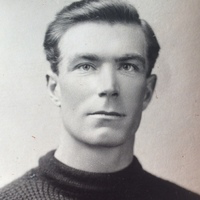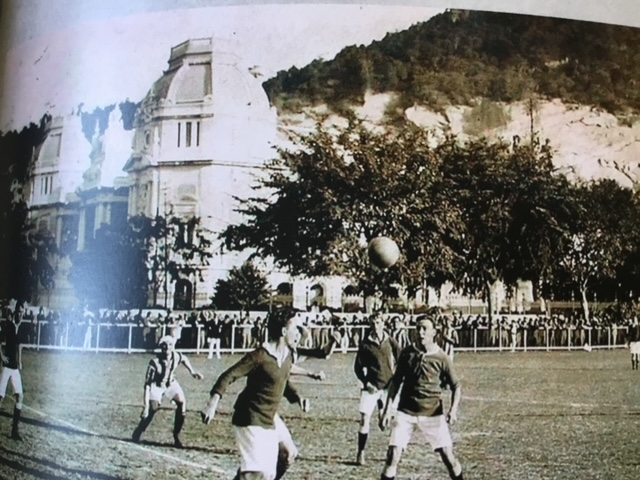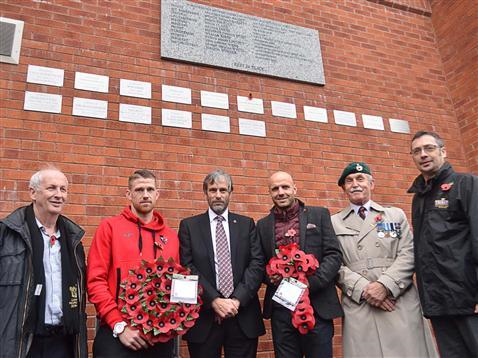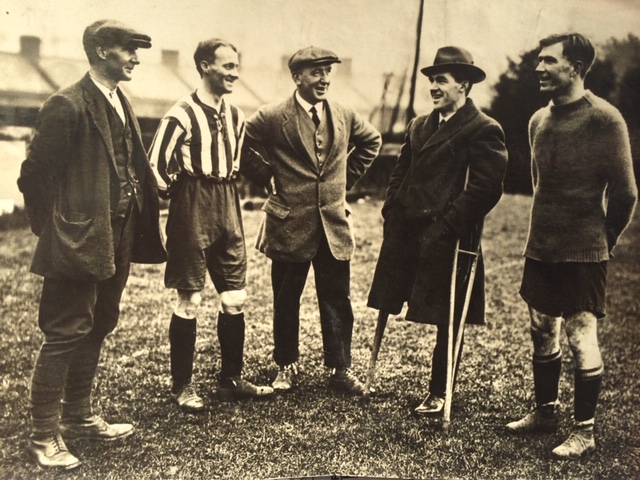Exeter City’s 1914 Tour of South America - How Two Balls Survived the Outbreak of World War One
01/03/2023 - 10.42
Martin Weiler
Given the year – 1914 – it was a pretty sure sign of the optimism of the time that the Football Associations of Argentina and England were busy trying to identify a club to make a summer tour to South America. The hosts were keen on Tottenham Hotspur who had successfully toured in 1909. Spurs declined and remarkably visited Germany instead. In the end, it was Exeter City who were selected and agreed to tour.
In the Exeter City Museum at St James Park there are two footballs which survived both the tour and the outbreak of the First World War on their way home. This is their story.
But first, why were Exeter City chosen to tour? The club was still relatively new in 1914. It had started out as St Sidwell’s United in 1901 and then changed its name to Exeter City at their AGM in 1904 – a reflection that they were now the top association side in the city. St Sidwell’s had started out on a ground just off Pinhoe Road and moved about a mile away to St James Park in 1903. Exeter City still play there.
To begin with the club were just an amateur team playing in local Exeter and then Plymouth Leagues. But they were ambitious and in 1908 the decision was made to turn professional and apply for membership of the strong Southern League. Once accepted, Exeter appointed England international Arthur Chadwick as their first professional manager and he set about recruiting a team of mainly experienced northern players.
To match this ambition, developments took place to transform St James Park from a simple field into a proper stadium. The pitch was flattened and a grandstand and terracing erected. One thing that didn’t change was the club’s unusual nickname – The Grecians. This was the name people living in the local St Sidwell’s neighbourhood were known as.
Exeter made a modest start to life in the Southern League, generally finishing around mid-table. Looking to change their luck the club switched from green and white kit to the now recognisable red and white stripes. Chadwick had played for Southampton and maybe took a shine to their colours. Local players started to be added to the squad, most notably goalkeeper Dick Pym from nearby Topsham.

Dick Pym. Source: Grecian Archive
It was at precisely the time that the English FA was looking for a team to tour Argentina that Exeter made a name for themselves. Drawn away to Portsmouth at Fratton Park in the first round of the FA Cup, the Grecians caused a real upset and won 4-0.
The profile of the club rose even further when they drew the cup holders Aston Villa in the next round – the first major game to be played at St James Park. Exeter went toe to toe with Villa and only narrowly lost 1-2.
The FA must have been impressed as City were invited to tour Argentina and accepted. And so it was that the party of players, including local man Dick Pym, and officials gathered at Queen Street (now Central) station to make their way to Southampton. Local newspapers reported on the departure and mentioned that the Supporters Club was there to see them off.
Once in Southampton the tourists boarded the Andes and travelled first class on the three-week voyage to South America. It was quite an experience for the mainly northern working class lads who numbered among their pre-football employment jobs such as coal miner, cotton side piecer, shipyard worker and hat works proofer.

Exeter City Touring Party 1914. Source: Grecian Archive
It is quite possible that the balls that are now displayed in the Grecian’s Museum were taken out on the ship by the club. They trained while aboard and had various stops along the way including Lisbon, Madeira and Rio. Further along the coast of Brazil they infamously stopped in Santos for a practice session. Boiling in the heat the squad took off their shirts and went for a dip in the sea. Little did they know but this was not allowed and they were all arrested for breaking the local public decency regulations. Thankfully they were soon released.
So what are the stories the two balls in the museum can tell? Well one seems to have been used in the very first game of the tour – writing on it indicates it was from the Exeter v Argentina North game. It was a bit of a comedown for Exeter. Still heavy with ‘sea legs’ (Dick Pym despite being a salmon fisherman suffered terribly from sea sickness) City had hardly 24 hours onshore to prepare.
It was a big occasion with an impressive programme produced for the large crowd of around 14,000. The game, like six of the eight games in Argentina, was played at the Avellaneda ground in Buenos Aires still home to this day of the famous Racing Club.
The result was a 1-0 win for Norte, the first time a British side had ever been beaten by an Argentinian team. Extensive newspaper reports, many with fabulous photos of the game and the crowd, made sure that the historic victory was well recorded.

Argentina North v Exeter City Crowd Scene. Source: Grecian Archive
Exeter settled down after this and beat the South 3-0 in the next game. Then in the third game the other ball in the Exeter Museum collection made an appearance. It was quite a match with City winning 2-0. However, when the first goal went in the Racing Secretary went onto the pitch with a revolver and threatened to shoot the referee. He had been outraged by Exeter’s ‘rough’ play. Thankfully tempers were calmed and the game resumed after the interlude.

Racing Club v Exeter City. Source: Grecian Archive
The tour originally was just meant to be in Argentina. City played eight games there – winning six and drawing one after the opening defeat. There had been talk on the way of a possible game in Uruguay (the boat had stopped there) but this didn’t come off. Instead, the big deal done was in Brazil, where local officials had negotiated for Exeter to play three games on their way home.
It was in the third of those games that Brazil fielded their national team – a mix of players from Rio and São Paulo - for the very first time. Yes, five times World Cup winners Brazil’s first ever match was against Exeter City. Brazil won 2-0 to boost their football and indeed national confidence.

Exeter City Playing in Brazil. Source: Grecian Archive
If you go to the Laranjeiras Stadium in Rio where the game was played, it is well worth a visit to the Fluminense Museum. There in this Museum is a dedicated room telling the story of the game and with a window looking out onto the pitch. In pride of place is the match ball – the third known ball connected to the tour. This made an appearance when Exeter returned for a centenary match in the same stadium in 2014.
So the 11 match tour came to an end and the Exeter party returned on the SS Alcantara, making its maiden voyage. There on board Dick Pym had squirrelled away two footballs. It’s possible he had more time to concentrate on tour ‘trophies’ as he had been injured in the penultimate game and took no further part. Instead, local farmer Reg Loram played in goal for the three games in Brazil – the only first team matches he ever turned out in.
It’s fortunate that Pym and the balls made it back. For it was just as the ship sailed off that the First World War was declared. The ship had to delicately make its way back through the fog of war. It was actually fired on three times – all friendly fire. The first from Britain’s HMS Vindictive and the other two by French vessels.
The ship finally made it safely home but because of the war, the story of the tour and indeed the two footballs were largely forgotten. It was only in the following century that the historic link was restored when the Brazil Masters, captained by Dunga, visited St James Park in 2004 to be followed by City’s centenary tour to Brazil in 2014.
Historians at Exeter made sure that those who had played for the club and died in World War One were remembered. The whole first team squad attended a ceremony in the St James Park memorial garden in 2014. A plaque listing those who died was unveiled.

Exeter City Remembers Its War Dead in 2014. Source: Grecian Archive
Amazingly given the carnage of the war not one of the players who toured South America was killed in action. But some did have career ending injuries, including Billy Smith who lost a leg.

Billy Smith Meeting Club Colleagues. Source: Grecian Archive
There is no doubt the Museum at Exeter owes its thanks to Dick Pym for safeguarding the two balls from the tour. Dick was transferred to Bolton Wanderers for £5000 in 1921. He went on to win three FA Cup winners medals, not once letting in a goal at these Wembley games, the first of which was the ‘White Horse’ final of 1923. He also played for England before retiring and going back to his beloved Topsham where he lived until the grand age of 95.
Pym’s contribution to the game will be celebrated this year at a special exhibition at Topsham Museum entitled ‘Dick Pym Fisherman & Footballer’. This will run from late April until October 2023 and will feature one of the South American balls. A blue plaque is also due to be put up in Topsham.
So how did the two balls finally make it to the Exeter City Museum? The first one to arrive was the one used in the match versus Racing. Dick had given this up for auction to raise funds for Topsham Youth Club in 1985. The then Chairman of Exeter City, Byron Snell, made the winning bid but shortly afterwards left the club. All was forgotten until an exhibition was held at St James Park in 2013 to mark the centenary of the tour. Byron got in touch and offered to loan the ball. When the Museum was established a few years later he donated the ball on a permanent basis.
At the time the Museum believed that was the only ball to make it back to Exeter. But surprise, surprise there was another one. When Dick’s grandson, Richard, got involved with the club and became Chairman of the Board, he revealed there was a second ball, the Argentina North one. This too was donated to the Museum.
So we have two fabulous pieces of football history to display - two balls that survived a perilous journey at the outset of World War One to give great pleasure today.
Note
With many thanks to Aidan Hamilton for his comments and advice. See Aidan’s book ‘Have you ever played Brazil? The story of Exeter City’s 1914 Tour to South America’ for a full account of the tour and the impact of World War One.
Biography
Brought up in London watching Hounslow Town, Brentford and Spurs, Martin studied History and Archaeology at the University of Exeter and stayed on to work and live in the Devon city. This led to following Exeter City and increasingly getting involved as the Supporters Trust became owners in 2003. Martin was a member of the Trust Board for nine years and in 2016-17 was Trust Chair and a Club Director. Martin is as Trustee of the Exeter City Football Club Museum Trust.



/prod01/wlvacuk/media/departments/digital-content-and-communications/images-2024/240328-Varsity-Line-Up-Resized.jpg)
/prod01/wlvacuk/media/departments/digital-content-and-communications/images-18-19/220325-Engineers_teach_thumbail.jpg)
/prod01/wlvacuk/media/departments/digital-content-and-communications/images-2024/240515-Spencer-Jones-Award-Resized.jpg)
/prod01/wlvacuk/media/departments/digital-content-and-communications/images-2024/240320-Uzbekistan-Resized.jpg)
/prod01/wlvacuk/media/departments/digital-content-and-communications/images-2024/240229-The-Link-Resized.jpg)
/prod01/wlvacuk/media/departments/digital-content-and-communications/images-2024/240516-Andy-Gibson-Resized.jpg)